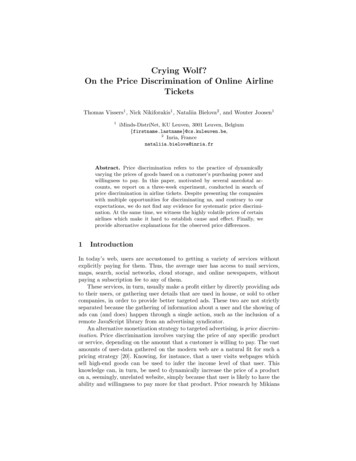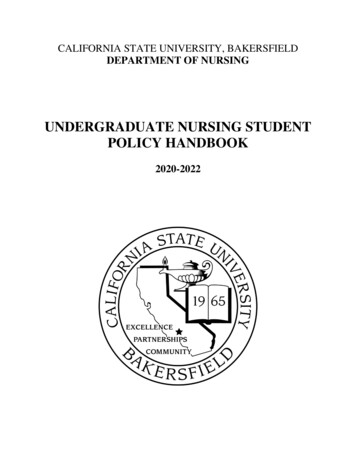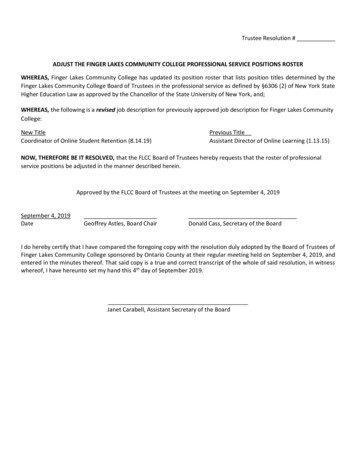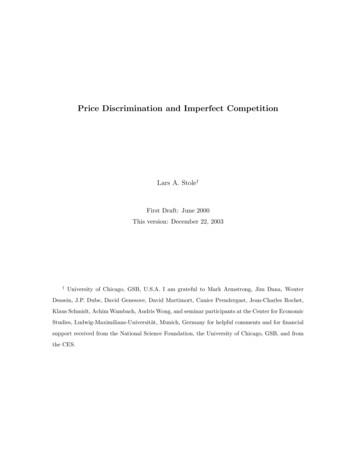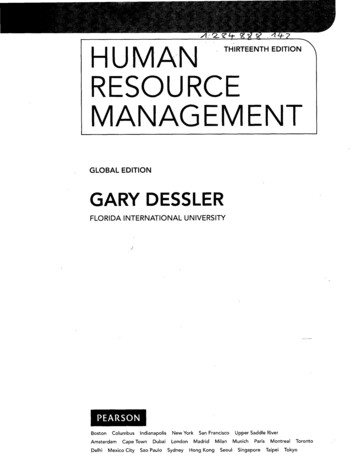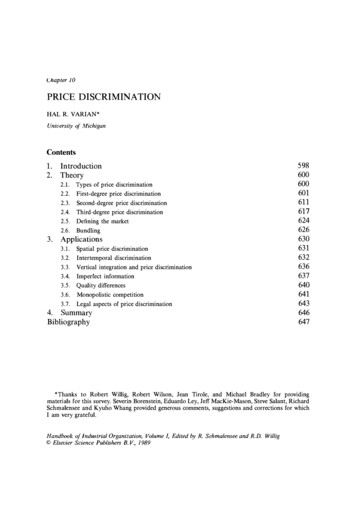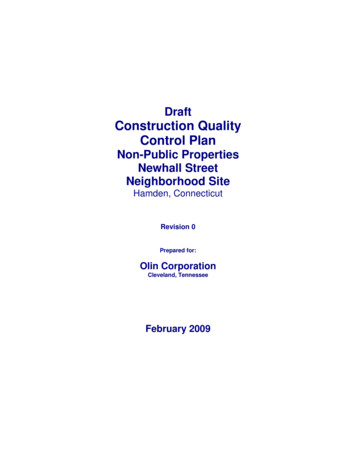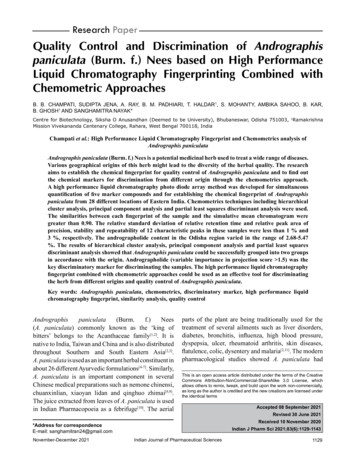
Transcription
Research PaperQuality Control and Discrimination of Andrographispaniculata (Burm. f.) Nees based on High PerformanceLiquid Chromatography Fingerprinting Combined withChemometric ApproachesB. B. CHAMPATI, SUDIPTA JENA, A. RAY, B. M. PADHIARI, T. HALDAR1, S. MOHANTY, AMBIKA SAHOO, B. KAR,B. GHOSH1 AND SANGHAMITRA NAYAK*Centre for Biotechnology, Siksha O Anusandhan (Deemed to be University), Bhubaneswar, Odisha 751003, 1RamakrishnaMission Vivekananda Centenary College, Rahara, West Bengal 700118, IndiaChampati et al.: High Performance Liquid Chromatography Fingerprint and Chemometrics analysis ofAndrographis paniculataAndrographis paniculata (Burm. f.) Nees is a potential medicinal herb used to treat a wide range of diseases.Various geographical origins of this herb might lead to the diversity of the herbal quality. The researchaims to establish the chemical fingerprint for quality control of Andrographis paniculata and to find outthe chemical markers for discrimination from different origin through the chemometrics approach.A high performance liquid chromatography photo diode array method was developed for simultaneousquantification of five marker compounds and for establishing the chemical fingerprint of Andrographispaniculata from 28 different locations of Eastern India. Chemometrics techniques including hierarchicalcluster analysis, principal component analysis and partial least squares discriminant analysis were used.The similarities between each fingerprint of the sample and the simulative mean chromatogram weregreater than 0.90. The relative standard deviation of relative retention time and relative peak area ofprecision, stability and repeatability of 12 characteristic peaks in these samples were less than 1 % and3 %, respectively. The andrographolide content in the Odisha region varied in the range of 2.68-5.47%. The results of hierarchical cluster analysis, principal component analysis and partial least squaresdiscriminant analysis showed that Andrographis paniculata could be successfully grouped into two groupsin accordance with the origin. Andrographolide (variable importance in projection score 1.5) was thekey discriminatory marker for discriminating the samples. The high performance liquid chromatographyfingerprint combined with chemometric approaches could be used as an effective tool for discriminatingthe herb from different origins and quality control of Andrographis paniculata.Key words: Andrographis paniculata, chemometrics, discriminatory marker, high performance liquidchromatography fingerprint, similarity analysis, quality controlAndrographispaniculata(Burm.f.)Nees(A. paniculata) commonly known as the ‘king ofbitters’ belongs to the Acanthaceae family[1,2]. It isnative to India, Taiwan and China and is also distributedthroughout Southern and South Eastern Asia[2,3].A. paniculata is used as an important herbal constituent inabout 26 different Ayurvedic formulations[4-7]. Similarly,A. paniculata is an important component in severalChinese medical preparations such as nemone chinensi,chuanxinlian, xiaoyan lidan and qinghuo zhimai[8,9].The juice extracted from leaves of A. paniculata is usedin Indian Pharmacopoeia as a febrifuge[10]. The aerialparts of the plant are being traditionally used for thetreatment of several ailments such as liver disorders,diabetes, bronchitis, influenza, high blood pressure,dyspepsia, ulcer, rheumatoid arthritis, skin diseases,flatulence, colic, dysentery and malaria[2,11]. The modernpharmacological studies showed A. paniculata hadThis is an open access article distributed under the terms of the CreativeCommons Attribution-NonCommercial-ShareAlike 3.0 License, whichallows others to remix, tweak, and build upon the work non-commercially,as long as the author is credited and the new creations are licensed underthe identical termsRevised 30 June 2021Received 10 November 2020*Address for correspondenceE-mail: sanghamitran24@gmail.comNovember-December 2021Accepted 08 September 2021Indian J Pharm Sci 2021;83(6):1129-1143Indian Journal of Pharmaceutical Sciences1129
www.ijpsonline.comgood anti-inflammatory, antioxidant, anticancer andimmune-stimulatory activity[12-15]. The potential healthbenefits of A. paniculata are mainly attributed due tothe presence of active constituents including diterpenelactones (andrographolide, dehydroandrographolide,neoandrographolide, deoxyandrographolide, 14-deoxy11,12-didehydroandrographide, andrograpanin andisoandrographolide) and flavonoids (andrographidine,apigenin and luteolin)[16-18].As specified in the various pharmacopoeia, herbalindustries measure the quality of A. paniculata basedon a single active constituent i.e., andrographolide.However, due to the complex components inA. paniculata, monitoring only the andrographolidecontent cannot offer comprehensive quality control forA. paniculata.Previously reported analytical methods for quantitativeanalysis of A. paniculata samples considered onlyone or two marker constituents[17,19-21]. None of thesereports have carried out a simultaneous separationand determination of multiple bioactive componentsof A. paniculata. In light of this, a multiple markerbased High Performance Liquid Chromatography(HPLC) fingerprint in combination with chemometricapproaches seems to be suitable for the qualityassessment of A. paniculata. Moreover, studies haveshown that the internal quality of A. paniculata is relatedto its habitat/geographical region[17]. Geographicalorigin and environmental factors affect the productionand accumulation of secondary metabolites[22,23]. Forthis reason, it is necessary to establish a fingerprint thatcould discriminate and distinguish between samples ofdifferent geographical origins.Nowadays, the chromatographic fingerprint hasbecome a most rational and powerful approach forauthentication, quality assessment and consistencyof the herbal product and has been accepted byWorld Health Organisation[24], Food and DrugAdministration[25] and European Medicines Agency[26].Various analytical methods such as High PerformanceThin Layer Chromatography (HPTLC), HPLC, GasChromatography (GC) and Capillary Electrophoresis(CE) have been recognized for the identification andquantification of herbal products. However, HPLC hasbeen extensively applied in fingerprint analysis due toits simplicity and cost-effectiveness[27-34]. Fingerprintpattern is a complex dataset due to the complex matrixof herbs and it is difficult to baseline and isolate all1130compounds[35]. Therefore, multivariate chemometricmethod including Hierarchical Cluster Analysis (HCA),Principal Component Analysis (PCA), Partial LeastSquare Method-Discriminant Analysis (PLS-DA),Artificial Neural Networks (ANNs) and DiscriminantAnalysis (DA) have been successfully applied incombination with chemical fingerprint to find out thediscriminatory chemical markers and reasonable patternrecognitions for identification and quality control ofherbal medicines[36-40].As far as we know, there are hardly any reports on thedevelopment of the effective method for differentiatingA. paniculata from different geographical regionsof India by integrating HPLC fingerprinting withchemometric methods. Thus, the purpose of the currentstudy was to develop an efficient HPLC fingerprintmethod for the quality assessment of A. paniculata incombination with chemometric methods. Additionally,semi-quantitative estimation of five biomarkers inextracts of A. paniculata collected from 28 differenthabitats was also carried out. Supervised andunsupervised techniques such as HCA, PCA and PLSDA were successfully used to classify and differentiateA. paniculata samples of different geographical origins.MATERIALS AND METHODSPlant material and reagents:A total of 28 batches of A. paniculata aerial parts werecollected across different geographical locations ofOdisha and West Bengal provinces from Septemberto November, 2019. Specifically, a total of 10 healthymature plants of A. paniculata with similar growthstature were collected from each geographical location.All the plants were identified and authenticated byDr. Pratap Chandra Panda, Principal Scientist, RegionalPlant Resource Centre, Bhubaneswar, Odisha, India andthe voucher specimens were deposited at the herbariumof the same institute (Table 1).Potassium dihydrogen phosphate, ortho-phosphoricacid, HPLC grade methanol, acetonitrile and water wereprocured from Merck Life Science Pvt. Ltd., Mumbai,India. Reference standards including ninand14-deoxy-11,12-didehydroandrographolide (fig. 1) ofpurity 99 % were procured from Natural RemediesPvt. Ltd., Bangalore, India and Neoandrographolide(fig. 1) from Cayman chemical company, Ann Arbor,Michigan, United States.Indian Journal of Pharmaceutical SciencesNovember-December 2021
www.ijpsonline.comTABLE 1: CONTENT (%) OF FIVE COMPOUNDS IN A. paniculata SAMPLES COLLECTED FROM DIFFERENTLOCATIONSS. North 24 ParganasBankuraBankuraNadiaNorth 24 ParganasNorth 24 ParganasNorth 24 ParganasNadiaNorth 24 ParganasBirbhumPurba MedinipurMaldahNorth 24 ParganasPaschim aOdishaOdishaOdishaOdishaOdishaOdishaWest BengalWest BengalWest BengalWest BengalWest BengalWest BengalWest BengalWest BengalWest BengalWest BengalWest BengalWest BengalWest BengalWest BengalWest 390.230.060.810.350.450.161.220.41Content Note: C1-Andrographolide, C2-Neoandrographolide, C3-14-deoxyandrographolide, C4-14-deoxy-11,12-didehydroandrographolide andC5-AndrograpaninPreparation of sample and standard solution:The aerial parts were shade dried after harvest andfinely powdered using a homogenizer. The powderedsamples were passed through a 250 µm sieve to obtaina fine powder. Each sample was accurately weighed to25 mg, kept in a volumetric flask and extracted with50 ml methanol in an ultrasonic bath for 20 min at 60 .After extraction, the sample containing solution wasfiltered through 0.22 µm syringe-driven filter into anHPLC vial for HPLC analysis. Stock solutions of fivereference standards were prepared in methanol and keptat 4 before HPLC analysis.HPLC instrumentationconditions:andchromatographicA Shimadzu HPLC system (Kyoto, Japan) comprisingof a binary LC-20 AD pump, an SPD-20A diodearray detector, CT0-20AC column oven, CBM-20ANovember-December 2021controller and a Rheodyne 8125 injector was usedfor HPLC analysis. The chromatographic separationwas carried out on Shimadzu Shimpak C18 column(250 4.6 mm, 5 µm) using solvent A (orthophosphatebuffer, pH 2.4) and solvent B (acetonitrile) as a mobilephase with a gradient flow from pump A as 95 % for0-17 min, 55 % for 18-24 min, 20 % for 25-34 min, 55 % for35-39 min, 95 % for 40-45 min subsequently. The flowrate was kept at 1.5 ml/min. The injection volumes of thesamples and the standard solutions were set as 20 µl. Thetotal run time was 45 min. The PDA detector was set at223 nm for acquiring chromatograms; the UV spectrawere recorded between 190-800 nm. Before HPLCanalysis, the freshly prepared HPLC mobile phase waspassed through a 0.45 µm membrane filter and degassedusing a sonicator. Different extraction techniques (heatreflux and ultrasonication) and extracting solvents(methanol, ethanol and water), solvent volume (10, 20and 50 ml), extraction temperature (20, 40 and 60 ) andIndian Journal of Pharmaceutical Sciences1131
www.ijpsonline.comFig. 1: Chemical structure of five investigated compoundsextraction time (10, 15 and 20 min) were assessed tooptimize sample preparation and extraction conditionusing a single factor experiment.Method validation of HPLC fingerprint andquantitative analysis:The developed HPLC fingerprint method was validatedin terms of precision, stability and repeatability of samplesolution (sample 13) as per the guidelines of State Foodand Drug Administration (SFDA) of China[41]. Theprecision test was carried out by analysing a sample(S13) and injecting it at three different times within a dayat a regular time interval and expressing the result as therelative standard deviation of Relative Retention Time(RRT) and Relative Peak Areas (RPA) of 12 commonpeaks with respect to reference peak 1. The stability ofthe sample solution was done by preparing a sample(S13) at once and injecting it at 0, 24 and 48 h. Therepeatability of the sample was determined by injectingbiological replicates of a sample solution (sample13). Three replicates were injected for repeatabilityanalysis. The method validation of quantitative analysiswas carried out for linearity, Limit of Detection (LOD)and Limit of Quantification (LOQ), precision, stability,repeatability and recovery test as per the guidelinesset by the International Conference on Harmonization1132(ICH)[42]. The LOD is the minimum concentration ofan analyte at which the peak area of the signal is atleast three times greater than the signal-to-noise ratio(S/N 3). The LOQ is the lowest concentration of ananalyte at which the peak area is at least ten times greaterthan the signal by noise ratio (S/N 10). The precisionwas determined by injecting the replicate solution ofeach standard three times within a day. The stability testof the standard was determined by injecting the samesolution of each standard for two consecutive days(0, 24, 48 h). The repeatability of each compound wasdetermined by independently preparing three replicatesof each reference standard solution. The recovery testwas determined by the method of standard addition,which was done by adding a known amount of standardto the analysed sample and then reanalysing.EstablishmentofHPLCchemometric analysis:fingerprintandThe HPLC chromatograms of 28 accessions ofA. paniculata aerial parts collected from differentgeographical locations of Eastern India were analysedby the professional software similarity evaluationsystem for the chromatographic fingerprint of traditionalChinese medicines (version 2004A). This analysistool is formulated by the Chinese PharmacopoeiaIndian Journal of Pharmaceutical SciencesNovember-December 2021
www.ijpsonline.comCommittee based on the principle of measurement ofcorrelative coefficient calculations for chromatographicfingerprints. The correlation coefficient of all thesamples was calculated and the simulated meanchromatograms, as well as common fingerprint peakswere generated. Relative peak areas of common peakswere normalized, scaled and filtered before statisticalanalysis, then the data are mean centred with unitvariance scaling for log transformed statistical analysis.HCA and PCA were performed using metaboanalyst4.0, a comprehensive web-based metabolomicsanalysis tool (https://www.metaboanalyst.ca/). HCAis an unsupervised classification technique used tocluster the objects in a two-dimensional space based onsimilarity or difference among the sample[43]. A 12 28matrix was formed by taking the relative peak areas ofcommon peaks of 28 accessions of A. paniculata fromdifferent geographical origins. The Dendrogram wascreated using the Euclidian matrix and Ward linkagemethod as amalgamation rule to explore clusteringpatterns among the sample. PCA is an unsupervisedtechnique widely used to reduce the dimension of theoriginal data set without losing enough information bytransforming a large no of variables into orthogonalones known as Principal Components[44]. PCAconstructed two major plots; score plot and loadingplot by which, the sample can be grouped based onsimilar pattern and the impact of variables on clusteringcould be investigated[22,45]. PLS-DA is a supervisedrecognition tool used for the separation of samples byminimizing the variance-covariance within a group ofsamples and maximize variance-covariance betweenthe groups of samples[43]. PLS-DA was carried out toenhance the group separation between the sample ofOdisha and West Bengal province. PLS-DA model wasvalidated based on multiple correlation coefficients (R2)in cross validation and permutation test by applying1000 interactions. The significance of metabolites wasranked using variable importance in projection scorefrom the PLS-DA model.RESULTS AND DISCUSSIONThe present findings showed that the efficient extractionfor A. paniculata was obtained in the ultrasonicationat 60 with methanol (50 ml) for 20 min. All theconstituents present in the A. paniculata were elutedout within 45 min. Gradient elution was tested usingorthophosphate buffer-methanol and orthophosphatebuffer-acetonitrile. However, the mobile phaseconsisting of orthophosphate buffer with pH 2.4 andacetonitrile was found to be most suitable as it gaveNovember-December 2021a large number of peaks and proper resolution ascompared to that of orthophosphate buffer-methanol.The better separation of the sample solution wasobserved at a flow rate of 1.5 ml/min. In order to geta reliable fingerprint and precise quantitative analysisof target constituents, the chromatogram was scannedin the entire UV range. A detection wavelength of223 nm was set as the detection wavelength becauseof the maximum absorbance intensity of five referencecompounds in standards solutions and extract.The HPLC chromatograms of A. paniculata accessioncollected from the different geographical locationsof Odisha and West Bengal are represented in fig. 2.The reference fingerprint which was considered asstandard characteristic A. paniculata of each provinceis shown in fig. 3. The similarity analysis revealedthat the correlation coefficient values of all thesamples from different regions were more than 0.90 %(Table 2). There were 12 characteristic peaks inthe HPLC fingerprint as they are present in all the28 accessions of A. paniculata. The characteristic peaksare selected as the peak having a relatively high peakarea with good resolution. Out of the 12 characteristicpeaks, a total of five peaks were identified namelyAndrographolide (Peak 1), Neoandrographolide(Peak 2), 14-Deoxyandrographolide (peak 3),14-deoxy-11,12-dideoxyandrographolide (peak 4)and Andrograpanin (peak 6) by comparing the ultraviolet spectra and retention time of the sample peakto that of the reference standards. The other sevencharacteristic fingerprint peaks were unknown. TheHPLC chromatograms of five standard peaks arerepresented in fig. 4. Peak 1 i.e., andrographolide wasselected as a reference peak because it had the highestpeak area and better shape among all 12 characteristicpeaks. The peak was clearly separated from other peaksand had good reproducibility. The fingerprint methodwas validated based on the relative retention time (theratio of peak retention time of target constituents to thereference constituent) and the relative peak area (theratio of peak area of sample constituents to the referenceconstituent). The average relative peak area and averagerelative retention times along with Relative StandardDeviation (RSD) were calculated which were given inTable 3. Among the twelve characteristic peaks, none ofthe peaks had a RSD value of RPA below 20 %. Thereis an evident batch-to-batch variation in the sample asthey were collected from different geographical origins.Thereby we may conclude that it was not possible tomonitor the RPA value; however, the RSD of RRT oftwelve peaks was below 1 %.Indian Journal of Pharmaceutical Sciences1133
www.ijpsonline.comFig. 2: HPLC chromatographic fingerprints of A. paniculata samples collected from different geographical location of (A) Odishaand (B) West BengalThe method of HPLC fingerprint analysis was validatedin terms of precision, repeatability and stability. TheRSD values of stability, precision and repeatability testswere listed in Table 4. The overall RSD value of RRT ofprecision, stability and repeatability were 0.31-0.85 %,0.22-0.91 % and 0.13-0.76 % respectively. Similarly,the overall RSD value of RPA of precision, stability andrepeatability were 0.35-0.94 %, 0.83-1.98 % and 0.282.06 % respectively.The linear regression equation for the individual targetconstituent was obtained using a calibration curve thatwas generated by plotting the peak area (y) against1134concentration (x, mg/l) of the target compound. Basedon chromatographic conditions established above, thecalibration curve showed good linearity (R2 0.995)for all the analytes within the tested concentrationrange (Table 5). The LOD and LOQ values determinedfor all the five compounds were in the range of 0.06-13.41 mg/l and 0.19-40.66 mg/l respectively. The RSDvalues of precision for all the investigated compoundswere less than 2 % (Table 6). In the stability test, it wasobserved that the standard solution was stable with theRSD value of investigated compounds to be less than2 %. The RSD values of the target constituents wereIndian Journal of Pharmaceutical SciencesNovember-December 2021
www.ijpsonline.comFig. 3: Reference chromatographic fingerprint of A. paniculata from (A) Odisha and (B) West Bengal. The peaks marked with 1-12in the chromatogram represent the twelve characteristic peaksTABLE 2: SIMILARITIES RESULTS OF CHROMATOGRAM OF 28 A. paniculata SAMPLES WITH RESPECTTO THEIR REFERENCE CHROMATOGRAMSimilarityS. NoSimilarityS. NoSimilarityS. NoSimilarityS1S. mber 2021Indian Journal of Pharmaceutical Sciences1135
www.ijpsonline.comFig. 4: HPLC chromatogram of five reference standards (Peak 1: andrographolide; Peak 2: neoandrographolide; Peak 3:14-deoxyandrographolide; Peak 4: 14-deoxy-11,12-didehydroandrographolide and Peak 5: andrograpanin)TABLE 3: THE RT, RRT, PA AND RPA OF 12 CHARACTERISTICS FINGERPRINT PEAKS IN A. paniclulata(n .020.51114470.0418.53AverageRSD (%)Average PARPAComponent2Average RTRRTPeakAverageRSD ote: *14-deoxy-11,12-didehydroandrographolide, RT-Retention Time, RRT-Relative Retention Time, PA-Peak Area, RPA-Relative Peak Area,RSD-Relative Standard DeviationTABLE 4: ANALYTICAL RESULTS OF PRECISION, STABILITY ANDCHARACTERISTICS PEAKS IN A. paniculata SAMPLE (SAMPLE 13)Peak no.1(R)2RSD of RRT (%)REPEATABILITYOF12RSD of RPA 0.760.690.830.34Note: R-Reference peak; RRT-Relative Retention Time; RPA-Relative Peak Area; RSD-Relative Standard Deviationin the range of 0.98-1.98 % indicating that the methodrepeatability was suitable. Subsequently the analysis1136was carried out and the result of recovery for all thefive compounds were in the range of 97.74-99.11 %Indian Journal of Pharmaceutical SciencesNovember-December 2021
www.ijpsonline.comand their RSD value was less than 3 % as shown inTable 7. The result showed that the method is accurate,valid and precise.-4.46 % (andrograpanin) and 0.22-2.67 % (14-deoxy-11,12-didehydroandrographolide) and the results aresummarized in Table 1.The developed HPLC method was successfullyapplied for the quantification of ndrographolide in 28 accessions ofA. paniculata. The identification of marker compounds inthe sample chromatogram was carried out by comparingthe retention times and the UV absorption spectra ofreference standards. The content ranges were 0.34-5.47 %(andrographolide), 0.06-1.22 % (neoandrographolide),0.14-3.47 % (14-deoxyandrographolide), 0.25The observation from the results of HCA clearlyrevealed that the samples were divided into twodistinct clusters (fig. 5). Cluster 1 consist of S1-S13samples derived from Odisha province whereas cluster2 consist of S14-S28 samples derived from WestBengal province. A dendrogram is formed separatingthe samples from two geographical regions. In order tofurther discriminate between Odisha and West Bengalsamples of A. paniculata, PCA analysis was carried outby taking relative peak area of 12 characteristic peaks(12 variables) of 28 A. paniculata samples of OdishaTABLE 5: LINEARITY, REGRESSION EQUATION, R2, LOD AND LOQ OF FIVE grapaninLinearity (mg/l)Regression equationR2LOD (mg/l)LOQ (mg/l)10-80y 38.07x 0.120.9991.996.033.75-60y 3.76x 0.010.99913.4140.666-48y 8.99x 0.020.9994.7514.416-96y 16.05x 0.060.9980.120.382.5-40y 13.43x 0.260.9950.060.19Note: *14-deoxy-11,12-didehydroandrographolide, y-Peak area; x-Concentration of the compound (mg/l); R2-Coefficient of determination;LOD-Limit of Detection; LOQ-Limit of QuantificationTABLE 6: ANALYTICAL RESULTS OF PRECISION, STABILITY, REPEATABILITY AND RECOVERY RATESOF FIVE COMPONENTS OF A. paniculataComponentAndrographolidePrecision (n 3)Stability (n 3)Repeatability (n 3)RSD (%)RSD (%)RSD 1.851.160.98Andrograpanin1.421.451.98Note: *14-deoxy-11,12-didehydroandrographolide; RSD-Relative Standard DeviationTABLE 7: RECOVERY RATES OF THE FIVE COMPONENTS OF A. paniculataComponentOriginal (mg/l) Added (mg/l) Found (mg/l) Recovery (%) Average Recovery (%) RSD 032.5499.3698.321.2218.0035.6597.01Note: RSD-Relative Standard DeviationNovember-December 2021Indian Journal of Pharmaceutical Sciences1137
www.ijpsonline.comand West Bengal province. The first two principalcomponents explained around 92.6 % of the totalvariation of the dataset. The First Principal Component(PC 1) accounted for 81.1 % of total variance whereasthe Second Principal Component (PC 2) explainedfor around 11.5 % of the total variance, respectively.Fig. 5: Hierarchical clustering analysis of 28 samples of A.paniculata from different geographic locations Odisha and WestBengal, () Odisha; () West bengalFig. 6: PCA score plot of 28 accessions of A. paniculata samples, (1138From the PCA score plot, a clear distinction betweenthe samples of Odisha and West Bengal was observed(fig. 6). Odisha samples were located on the left sideof the score plot whereas samples from West Bengalwere located on the right side of the score plot. Ascan be seen in the loading plot that andrographolideappeared to influence the samples from Odisha(fig. 7). Additionally, the PLS-DA score plot showedbetter and distinct separation of samples into twogroups in accordance with their origin as comparedto PCA (fig. 8). Component 1 and component2 explained around 86 % of the total variance of analysedsamples. The predictive performance of the model wasevaluated based on model parameters R2Y and Q2Y.The values obtained for R2Y and Q2Y were 0.96 and0.91 computed using cross-validation. Samples withVariable Importance for the Projection (VIP) 1.5 havemore influence on sample discrimination. The plotin fig. 9 showed the VIP score of all peaks, showingthe influence of each peak on distinguishing betweenA. paniculata samples from different geographicalorigins.An appropriate extraction technique and HPLCparameters are necessary for obtaining useful chemicalinformation and getting well-separated fingerprintprofiles of five reference standards and A. paniculatasamples. Among the solvents used, it was found thatmethanol gave the best results. Previous studies) Odisha; () West BengalIndian Journal of Pharmaceutical SciencesNovember-December 2021
www.ijpsonline.comFig. 7: PCA loading plot of all variables (peaks 1-12) including identified constituentsFig. 8: PLS-DA score plot showing separation of A. paniculata samples from different geographical origin, (BengalNovember-December 2021Indian Journal of Pharmaceutical Sciences) Odisha; () West1139
www.ijpsonline.comFig. 9: VIP score plot for determination of important constituents (VIP score 1) based on PLS-DAhave also selected methanol as the best solvent forA. paniculata extract from commonly available solventslike chloroform, water, hexane and methanol[19]. On theother hand, it was imperative to optimize the detectionwavelength, mobile phase and flow rate to obtain thepeak separation of the HPLC fingerprint chromatogramsof A. paniculata. A detecti
Champati et al.: High Performance Liquid Chromatography Fingerprint and Chemometrics analysis of Andrographis paniculata Andrographis paniculata (Burm. f.) Nees is a potential medicinal herb used to treat a wide range of diseases. Various geographical origins of this herb might
